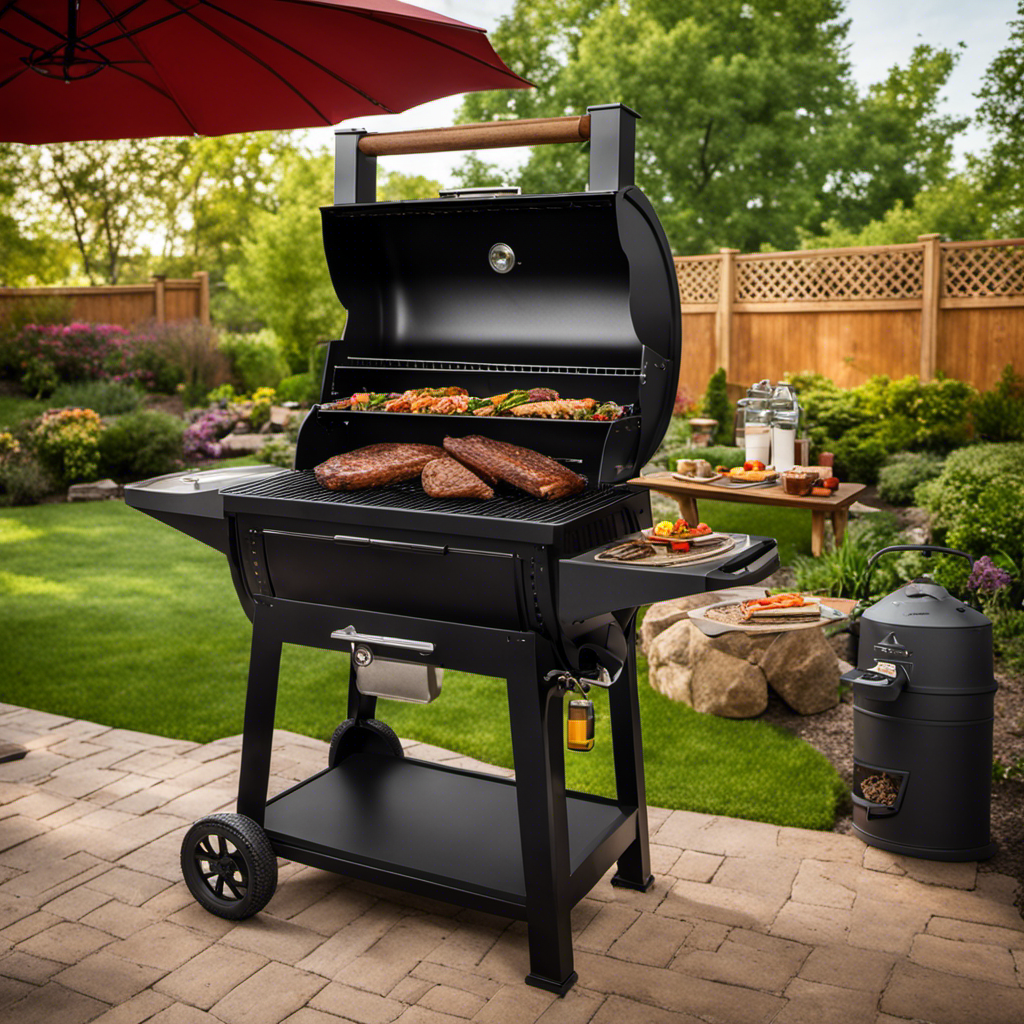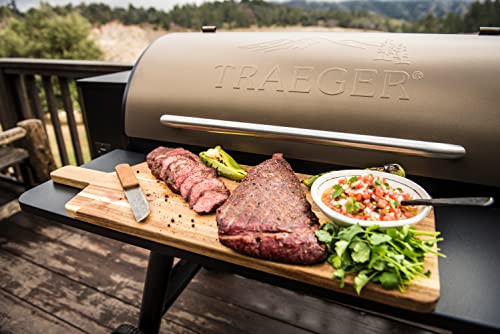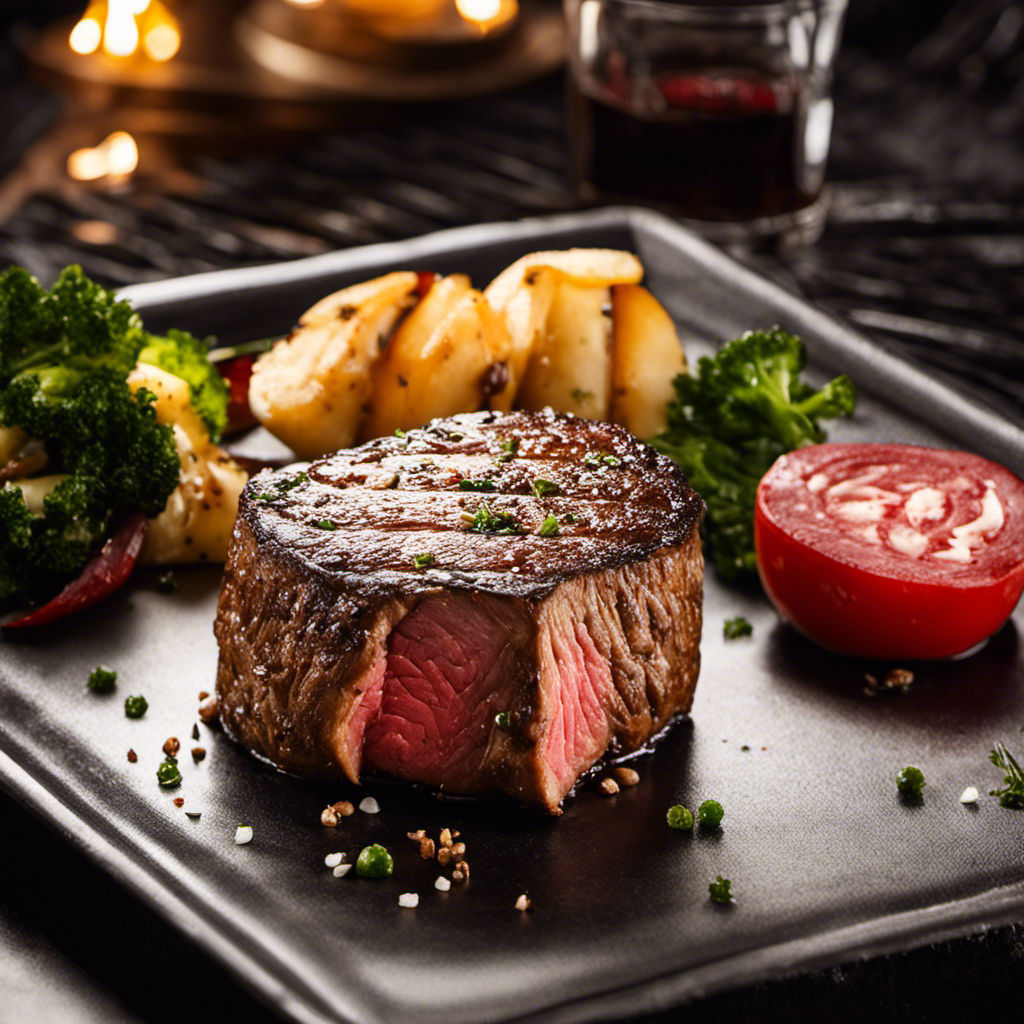I hold a deep admiration for the delightful scent of a flawlessly grilled pork tenderloin on a wood pellet grill. The sound of sizzling on the hot grates, the captivating mix of spices permeating the meat, and the succulent tenderness that comes with every bite – it’s a gastronomic experience too tempting to ignore.
In this article, I’ll guide you through the step-by-step process of how to achieve that ideal pork tenderloin roast on your wood pellet grill. Get ready to impress your guests and elevate your grilling game to new heights.
Key Takeaways
- Choosing a fresh and tender pork tenderloin with minimal fat and connective tissue is important for better flavor absorption during marination.
- Season the pork tenderloin with your preferred seasoning options, such as a classic rub, Asian marinade, or herb crust, based on personal taste preference.
- Cook the pork tenderloin on a wood pellet grill at an internal temperature of 145°F (63°C) for juicy and tender results.
- Allow the pork tenderloin to rest for about 10 minutes before slicing to redistribute juices and achieve maximum tenderness.
Choosing the Right Pork Tenderloin
When choosing the right pork tenderloin, it’s important to look for one that is firm and has a pinkish color. The firmness indicates freshness and tenderness, while the pink color signifies that the meat is still fresh and hasn’t started to spoil.
When it comes to pork tenderloin selection, it’s also crucial to consider the marinating techniques you plan to use. A good pork tenderloin should have minimal fat and connective tissue, as these can affect the absorption of flavors during marination. Opt for a lean cut with a consistent thickness for even cooking.
Now that you’ve chosen the perfect pork tenderloin, let’s move on to preparing the wood pellet grill for a delicious roast.
Preparing the Wood Pellet Grill
Make sure you’ve got all the necessary ingredients and tools ready for preparing your wood pellet grill.
Before you start cooking, it’s important to clean your wood pellet grill. Remove any leftover debris from the previous use by scraping the grates with a grill brush.
Next, empty the ash from the grill and clean the inside with a damp cloth.
Once your grill is clean, it’s time to add the wood pellets. Fill the hopper with your preferred flavor of wood pellets. Make sure to choose a high-quality brand for the best results. The amount of pellets you’ll need will depend on the size of your grill and the duration of cooking.
Now that your grill is clean and filled with wood pellets, it’s time to move on to seasoning the pork tenderloin.
Seasoning the Pork Tenderloin
When it comes to seasoning a pork tenderloin, the options are endless. From classic combinations like salt, pepper, and garlic powder to more adventurous flavors like chili powder and cumin, the choice is yours. The best seasoning option ultimately depends on your personal taste preference and the flavor profile you want to achieve.
As for cooking time recommendations, it’s important to remember that pork tenderloin is a lean cut of meat that can easily dry out if overcooked. Aim for an internal temperature of 145°F (63°C) and allow the meat to rest for a few minutes before slicing for juicy and tender results.
Best Seasoning Options
To enhance the flavor of your pork tenderloin roast on a wood pellet grill, you’ll want to try out some of these seasoning options. Here are three tried and true choices that will take your pork to the next level:
-
Classic Rub: A simple blend of salt, pepper, garlic powder, and paprika can work wonders for your pork tenderloin. It adds a savory and smoky flavor that complements the natural taste of the meat.
-
Asian Marinade: Infuse your pork with a burst of Asian flavors by marinating it in a mixture of soy sauce, ginger, garlic, and honey. This marinade adds a sweet and tangy taste that pairs perfectly with the smokiness of the grill.
-
Herb Crust: Create a delicious herb crust by combining fresh herbs like rosemary, thyme, and parsley with olive oil and garlic. This crust adds a fragrant and aromatic element to your pork tenderloin.
Now that you’ve seasoned your pork, let’s move on to cooking time recommendations to ensure that it turns out perfectly juicy and tender.
Cooking Time Recommendations
After seasoning your pork, it’s important to cook it for the right amount of time to ensure it is juicy and tender. Cooking time recommendations may vary depending on the size of your pork tenderloin and the cooking techniques you choose to use. Here is a table with some general guidelines for cooking pork tenderloin on a wood pellet grill:
| Weight | Cooking Time |
|---|---|
| 1-1.5 lbs | 20-25 minutes |
| 1.5-2 lbs | 25-30 minutes |
| 2-2.5 lbs | 30-35 minutes |
| 2.5-3 lbs | 35-40 minutes |
These cooking times are approximate and can be adjusted based on your desired level of doneness. It’s always recommended to use a meat thermometer to ensure the internal temperature reaches 145°F for medium-rare or 160°F for medium. Once your pork tenderloin is cooked to perfection, you can experiment with different flavor variations by adding glazes, rubs, or marinades. Now let’s move on to the next section and talk about cooking temperature and time without missing a beat.
Cooking Temperature and Time
The ideal cooking temperature for a pork tenderloin roast on a wood pellet grill is around 325 degrees Fahrenheit. This temperature allows for a slow and even cooking process, ensuring that the roast is tender and juicy. Cooking at higher temperatures can result in a dry and overcooked roast.
To achieve a smoky flavor, I recommend using the smoking technique on your wood pellet grill. Here are some tips for achieving the perfect smoky flavor on your pork tenderloin roast:
- Use wood pellets that complement the flavor of pork, such as hickory or apple.
- Preheat your grill and allow the wood pellets to fully ignite and produce smoke before placing the roast on the grill.
- Maintain a consistent temperature throughout the cooking process to ensure a steady release of smoky flavor.
- Consider using a dry rub or marinade to enhance the smoky taste.
Now that we have the ideal cooking temperature and smoking technique covered, let’s move on to monitoring and flipping the roast to ensure it is cooked to perfection.
Monitoring and Flipping the Roast
Keep an eye on the internal temperature of your pork tenderloin as it cooks, flipping it occasionally to ensure even browning and doneness. This is crucial for monitoring temperature and checking for doneness. To help you keep track, here’s a handy table to refer to:
| Internal Temperature | Doneness |
|---|---|
| 145°F (63°C) | Medium |
| 160°F (71°C) | Medium Well |
| 165°F (74°C) | Well Done |
By regularly checking the internal temperature with a meat thermometer, you can ensure that your pork tenderloin is cooked to your desired level of doneness. Remember, the USDA recommends cooking pork to an internal temperature of at least 145°F (63°C), but some prefer it cooked a bit more.
Once your pork tenderloin reaches the desired temperature, it’s time to let it rest before slicing. This allows the juices to redistribute, resulting in a moist and tender roast.
Resting and Slicing the Pork Tenderloin
Resting time is crucial when it comes to achieving the perfect tenderness and juiciness in a pork tenderloin. During this period, the meat fibers relax and redistribute their juices, resulting in a more flavorful and succulent cut.
When it comes to slicing techniques, it’s important to cut against the grain to ensure maximum tenderness.
Lastly, paying attention to the temperature at which you slice the pork is essential for achieving clean, precise cuts without compromising its texture or juiciness.
Resting Time Importance
After cooking, it’s crucial to let the pork tenderloin roast rest to allow the juices to redistribute and the flavors to develop. Resting time is often overlooked, but it plays a vital role in ensuring a tender and flavorful pork roast.
The resting time benefits are numerous. Firstly, it allows the meat to relax, resulting in a more tender texture. Secondly, it allows the juices to evenly distribute throughout the meat, preventing them from escaping when sliced. Lastly, it gives time for the flavors to meld together, enhancing the overall taste of the roast.
To maximize the resting time benefits, there are a few techniques you can employ. First, cover the roast loosely with aluminum foil to retain heat. Second, let it rest for at least 10 to 15 minutes before slicing. This will allow the meat to retain its juiciness and tenderness.
Speaking of slicing techniques for tenderness…
Slicing Techniques for Tenderness
To ensure a tender and flavorful slice of pork, it’s important to let the meat cool down slightly before slicing. This resting period allows the juices to redistribute throughout the meat, resulting in a more succulent and tender texture.
When it comes to slicing techniques for tenderness, there are a few key tips to keep in mind:
- Use a sharp knife: A sharp knife ensures clean and smooth cuts, preventing any tearing or shredding of the meat.
- Slice against the grain: Cutting against the grain helps break down the muscle fibers, making the pork more tender.
- Cut uniform slices: Consistency in slice thickness ensures even cooking and prevents some pieces from being overcooked while others are undercooked.
- Slice at a slight angle: Slicing at a slight angle creates larger surface areas, allowing the meat to absorb more flavor.
Proper slicing techniques are crucial for achieving the desired tenderness in your pork roast. Now, let’s move on to the next section, where we’ll discuss the ideal temperature for perfect slicing.
Temperature for Perfect Slicing
Achieving the perfect temperature is key to ensuring that your slices of pork are tender and juicy. When it comes to cooking a pork tenderloin roast, getting the temperature just right is crucial. The ideal internal temperature for a perfectly cooked pork tenderloin is 145°F (63°C). This temperature allows the meat to be cooked through while still maintaining its tenderness and juiciness. To achieve this perfect temperature, it is important to use a reliable meat thermometer to monitor the internal temperature of the roast. Here is a table to help you understand the doneness of the pork based on its internal temperature:
| Internal Temperature | Doneness |
|---|---|
| 120°F (49°C) – 130°F (54°C) | Rare |
| 130°F (54°C) – 140°F (60°C) | Medium Rare |
| 140°F (60°C) – 150°F (66°C) | Medium |
| 150°F (66°C) – 160°F (71°C) | Medium Well |
Serving and Enjoying the Perfect Roast
Once the roast is fully cooked, it’s time to slice and savor the delicious flavors. To ensure an enjoyable presentation, I recommend letting the roast rest for about 10 minutes before slicing. This allows the juices to redistribute and keeps the meat tender and moist.
When slicing, make sure to use a sharp knife and cut against the grain for maximum tenderness.
As for serving suggestions, you can never go wrong with a side of roasted vegetables or creamy mashed potatoes. For an extra touch, drizzle some homemade gravy over the slices of pork tenderloin. The combination of flavors will elevate your meal to a whole new level of deliciousness.
So go ahead, slice, serve, and enjoy!
Frequently Asked Questions
Can I Use a Gas or Charcoal Grill Instead of a Wood Pellet Grill for Cooking a Pork Tenderloin Roast?
I can use a gas or charcoal grill for cooking a pork tenderloin roast, but there are benefits to using a wood pellet grill. It provides a smoky flavor and consistent temperature control for a delicious and tender roast.
How Long Should I Marinate the Pork Tenderloin Before Seasoning It?
I usually marinate pork tenderloin for at least two hours before seasoning it. Marinating helps tenderize the meat and infuse it with flavors. It’s a great way to enhance the taste and juiciness of the roast.
Can I Use a Dry Rub Instead of a Marinade to Season the Pork Tenderloin?
Yes, you can definitely use a dry rub instead of a marinade to season the pork tenderloin. It will add a delicious flavor and create a nice crust when cooked on a wood pellet grill.
What Is the Recommended Internal Temperature for a Perfectly Cooked Pork Tenderloin Roast?
For a perfectly cooked pork tenderloin roast, the recommended internal temperature is 145°F. This ensures a juicy and tender result. Using a wood pellet grill adds a smoky flavor that enhances the overall taste.
Can I Cook Other Meats or Vegetables Alongside the Pork Tenderloin on the Wood Pellet Grill?
Sure, you can definitely cook other meats or vegetables alongside the pork tenderloin on the wood pellet grill. It’s a versatile cooking technique that allows for delicious flavor pairings.
Conclusion
In conclusion, cooking a pork tenderloin roast on a wood pellet grill is a delicious and satisfying experience.
As the tenderloin slowly cooks over the smoky heat of the wood pellets, it becomes infused with rich and savory flavors.
The aroma that fills the air is irresistible, making your mouth water in anticipation.
Once cooked to perfection, the tenderloin is juicy and tender, with a beautiful golden crust.
Slicing into it reveals the perfectly cooked meat, ready to be enjoyed with your favorite sides.
So fire up that wood pellet grill and get ready to indulge in a mouthwatering pork tenderloin roast like no other.











